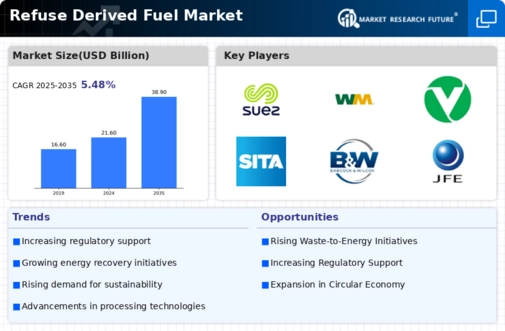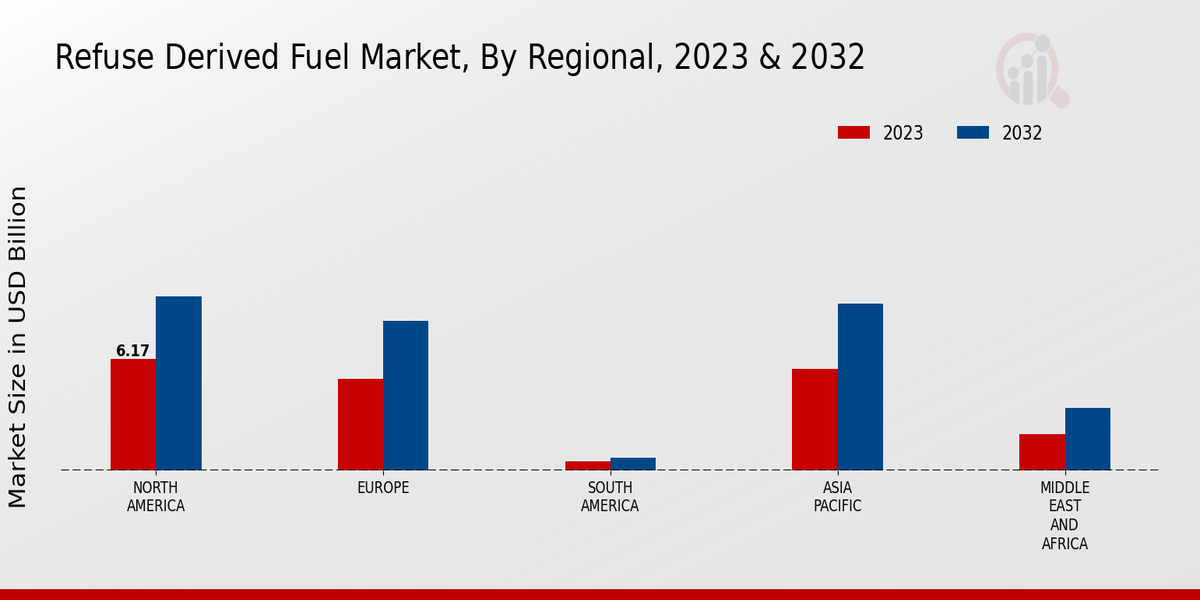Market Growth Projections
The Global Refuse Derived Fuel Market Industry is projected to experience substantial growth, with estimates indicating a market value of 21.6 USD Billion in 2024 and a potential increase to 38.9 USD Billion by 2035. This growth trajectory suggests a compound annual growth rate of 5.48% from 2025 to 2035. The increasing focus on sustainable waste management practices, coupled with technological advancements and regulatory support, is likely to drive this expansion. As stakeholders recognize the importance of refuse derived fuel in achieving energy security and environmental goals, the market is poised for significant developments in the coming years.
Increasing Waste Generation
The Global Refuse Derived Fuel Market Industry is experiencing growth due to the rising volume of waste generated worldwide. As urbanization continues to escalate, cities are producing more municipal solid waste, which necessitates effective waste management solutions. In 2024, the market is valued at 21.6 USD Billion, reflecting the urgent need for alternative fuel sources derived from waste. This trend is particularly pronounced in developing countries, where waste management infrastructure is often inadequate. The conversion of waste into refuse derived fuel not only addresses waste disposal challenges but also contributes to energy production, thereby enhancing sustainability efforts globally.
Growing Demand for Renewable Energy Sources
The increasing demand for renewable energy sources is a crucial factor driving the Global Refuse Derived Fuel Market Industry. As nations strive to reduce their carbon footprints and transition to cleaner energy alternatives, refuse derived fuel presents a viable solution. This fuel can replace fossil fuels in various applications, including power generation and industrial processes. The market's growth is further supported by the global shift towards sustainability, with many countries setting ambitious renewable energy targets. Consequently, the market is anticipated to expand significantly, reflecting the global commitment to reducing reliance on conventional energy sources.
Economic Benefits of Waste-to-Fuel Conversion
The economic advantages associated with converting waste to fuel are increasingly recognized within the Global Refuse Derived Fuel Market Industry. This conversion process not only mitigates waste disposal costs but also generates revenue through energy production. Municipalities and private enterprises are realizing the financial potential of refuse derived fuel, which can lead to job creation and stimulate local economies. As the market evolves, stakeholders are likely to invest more in waste-to-fuel technologies, recognizing their dual benefits of economic viability and environmental sustainability. This trend is expected to further bolster market growth in the coming years.
Technological Advancements in Fuel Production
Technological innovations in the production of refuse derived fuel are significantly influencing the Global Refuse Derived Fuel Market Industry. Advanced processing techniques, such as mechanical biological treatment and pyrolysis, enhance the efficiency of converting waste into fuel. These technologies improve the quality of the fuel produced, making it more viable for energy generation. As a result, the market is expected to grow at a CAGR of 5.48% from 2025 to 2035. The adoption of these technologies not only increases the yield of refuse derived fuel but also reduces the environmental impact associated with waste disposal.
Regulatory Support for Waste-to-Energy Initiatives
Government policies and regulations promoting waste-to-energy initiatives are pivotal drivers of the Global Refuse Derived Fuel Market Industry. Many countries are implementing stringent waste management regulations that encourage the conversion of waste into energy. For instance, the European Union has set ambitious recycling and recovery targets, which have spurred investments in refuse derived fuel technologies. This regulatory framework not only facilitates the growth of the market but also aligns with global sustainability goals. As a result, the market is projected to reach 38.9 USD Billion by 2035, indicating a robust response to regulatory incentives.















